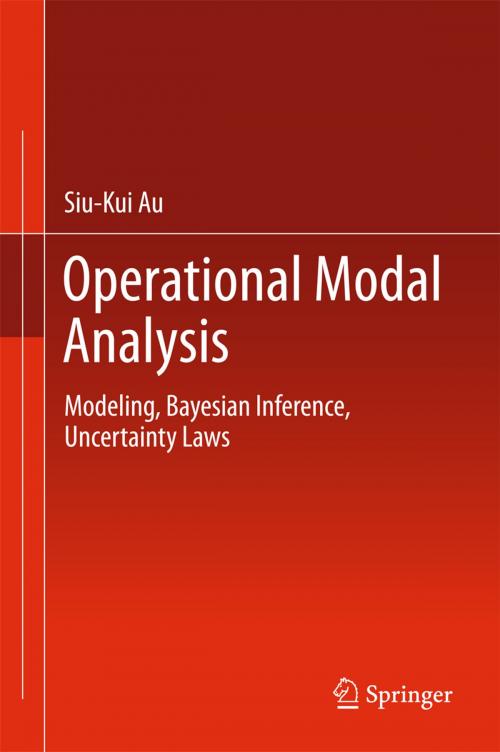Operational Modal Analysis
Modeling, Bayesian Inference, Uncertainty Laws
Nonfiction, Science & Nature, Science, Physics, Mechanics, Earth Sciences, Technology| Author: | Siu-Kui Au | ISBN: | 9789811041181 |
| Publisher: | Springer Singapore | Publication: | June 25, 2017 |
| Imprint: | Springer | Language: | English |
| Author: | Siu-Kui Au |
| ISBN: | 9789811041181 |
| Publisher: | Springer Singapore |
| Publication: | June 25, 2017 |
| Imprint: | Springer |
| Language: | English |
This book presents operational modal analysis (OMA), employing a coherent and comprehensive Bayesian framework for modal identification and covering stochastic modeling, theoretical formulations, computational algorithms, and practical applications. Mathematical similarities and philosophical differences between Bayesian and classical statistical approaches to system identification are discussed, allowing their mathematical tools to be shared and their results correctly interpreted.
Many chapters can be used as lecture notes for the general topic they cover beyond the OMA context. After an introductory chapter (1), Chapters 2–7 present the general theory of stochastic modeling and analysis of ambient vibrations. Readers are first introduced to the spectral analysis of deterministic time series (2) and structural dynamics (3), which do not require the use of probability concepts. The concepts and techniques in these chapters are subsequently extended to a probabilistic context in Chapter 4 (on stochastic processes) and in Chapter 5 (on stochastic structural dynamics). In turn, Chapter 6 introduces the basics of ambient vibration instrumentation and data characteristics, while Chapter 7 discusses the analysis and simulation of OMA data, covering different types of data encountered in practice. Bayesian and classical statistical approaches to system identification are introduced in a general context in Chapters 8 and 9, respectively.
Chapter 10 provides an overview of different Bayesian OMA formulations, followed by a general discussion of computational issues in Chapter 11. Efficient algorithms for different contexts are discussed in Chapters 12–14 (single mode, multi-mode, and multi-setup). Intended for readers with a minimal background in mathematics, Chapter 15 presents the ‘uncertainty laws’ in OMA, one of the latest advances that establish the achievable precision limit of OMA and provide a scientific basis for planning ambient vibration tests. Lastly Chapter 16 discusses the mathematical theory behind the results in Chapter 15, addressing the needs of researchers interested in learning the techniques for further development. Three appendix chapters round out the coverage.
This book is primarily intended for graduate/senior undergraduate students and researchers, although practitioners will also find the book a useful reference guide. It covers materials from introductory to advanced level, which are classified accordingly to ensure easy access. Readers with an undergraduate-level background in probability and statistics will find the book an invaluable resource, regardless of whether they are Bayesian or non-Bayesian.
This book presents operational modal analysis (OMA), employing a coherent and comprehensive Bayesian framework for modal identification and covering stochastic modeling, theoretical formulations, computational algorithms, and practical applications. Mathematical similarities and philosophical differences between Bayesian and classical statistical approaches to system identification are discussed, allowing their mathematical tools to be shared and their results correctly interpreted.
Many chapters can be used as lecture notes for the general topic they cover beyond the OMA context. After an introductory chapter (1), Chapters 2–7 present the general theory of stochastic modeling and analysis of ambient vibrations. Readers are first introduced to the spectral analysis of deterministic time series (2) and structural dynamics (3), which do not require the use of probability concepts. The concepts and techniques in these chapters are subsequently extended to a probabilistic context in Chapter 4 (on stochastic processes) and in Chapter 5 (on stochastic structural dynamics). In turn, Chapter 6 introduces the basics of ambient vibration instrumentation and data characteristics, while Chapter 7 discusses the analysis and simulation of OMA data, covering different types of data encountered in practice. Bayesian and classical statistical approaches to system identification are introduced in a general context in Chapters 8 and 9, respectively.
Chapter 10 provides an overview of different Bayesian OMA formulations, followed by a general discussion of computational issues in Chapter 11. Efficient algorithms for different contexts are discussed in Chapters 12–14 (single mode, multi-mode, and multi-setup). Intended for readers with a minimal background in mathematics, Chapter 15 presents the ‘uncertainty laws’ in OMA, one of the latest advances that establish the achievable precision limit of OMA and provide a scientific basis for planning ambient vibration tests. Lastly Chapter 16 discusses the mathematical theory behind the results in Chapter 15, addressing the needs of researchers interested in learning the techniques for further development. Three appendix chapters round out the coverage.
This book is primarily intended for graduate/senior undergraduate students and researchers, although practitioners will also find the book a useful reference guide. It covers materials from introductory to advanced level, which are classified accordingly to ensure easy access. Readers with an undergraduate-level background in probability and statistics will find the book an invaluable resource, regardless of whether they are Bayesian or non-Bayesian.















